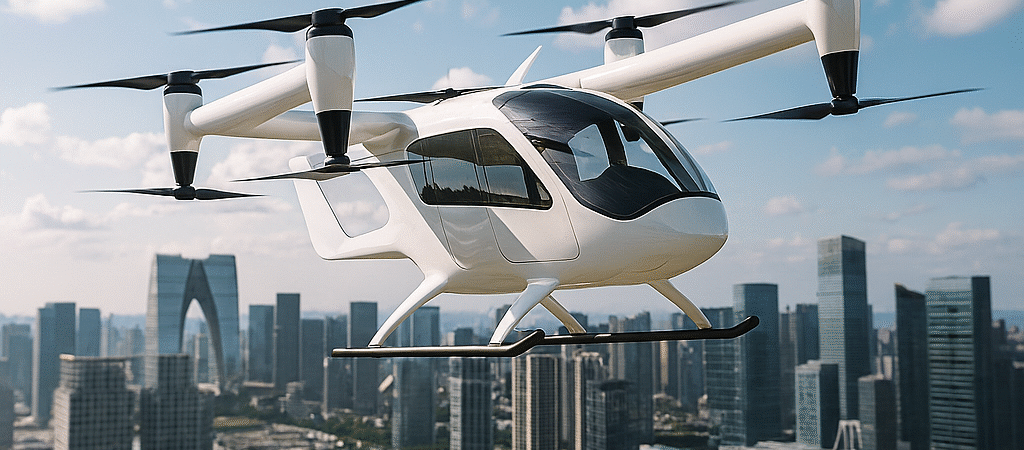🚁 The Rise of Electric Vertical Take-Off and Landing Aircraft (eVTOL)
Electric vertical take-off and landing aircraft, commonly referred to by the acronym eVTOL, are poised to revolutionize urban mobility. The first commercial flights are expected within the next few years, and several companies have already secured funding to build fleets ready for deployment. Behind this race to the skies are a number of publicly traded firms.
In the United States, Joby Aviation has developed a five-seat aircraft capable of covering approximately 240 kilometers on a single charge. The company collaborates with Toyota and recently acquired Blade, an operator of helicopter and air taxi services, to secure the infrastructure needed for future operations. Also in the U.S., Archer Aviation aims to launch its Midnight aircraft by 2025, having already obtained key certifications from aviation authorities.
In China, EHang has achieved a major milestone: it is the first company to receive approval for a fully autonomous passenger air taxi. Demonstration flights are already underway, and the company is exporting its EH216-S model to Africa—marking a historic step toward broader societal acceptance of this technology.
Brazil is entering the fray with Eve Air Mobility, a spin-off of Embraer, which plans to begin operations by 2026. While the prospects are exciting, they remain complex: safety is paramount and requires rigorous certification processes, and questions persist regarding the cost of service delivery.
📊 Financial Snapshot of Key Players
All companies in the sector are expected to operate at a loss for the foreseeable future, with the exception of EHang Holdings, listed on the New York Stock Exchange via ADR. EHang not only develops drones and eVTOL aircraft for passenger and cargo transport, but also offers smart city solutions and drone-based entertainment.
Since 2017, EHang has never posted a profit, not even at the EBITDA level. However, after closing 2024 with a loss of $0.24 per share and projecting further losses in 2025 (-$0.06), analysts anticipate a turnaround with a profit of $0.31 per share in 2026 and $0.59 in 2027. In Q2 2025, the company reported a 44% year-over-year revenue increase and an adjusted net profit of 9.4 million yuan—although the unadjusted figures still reflect a significant net loss. EHang expects to reach 500 million yuan in revenue by 2025, up from 456 million in 2024.
It remains a very small company (500 million yuan is approximately €60 million), and while it may appeal to speculative investors, the sector itself remains highly risky due to its nascent nature.
✈️ eVTOL Sector Companies Overview
Note: Source: Refinitiv, based on analyst consensus data.
- P/E Ratio: Price-to-Earnings
- P/BV Ratio: Price-to-Book Value
- EV/EBITDA: Enterprise Value to EBITDA
Lower values in all three metrics are generally more favorable.
For methodology on momentum and quality ratings, visit: Altroconsumo Methodology
“neg.” indicates negative values, rendering the metric non-significant.
